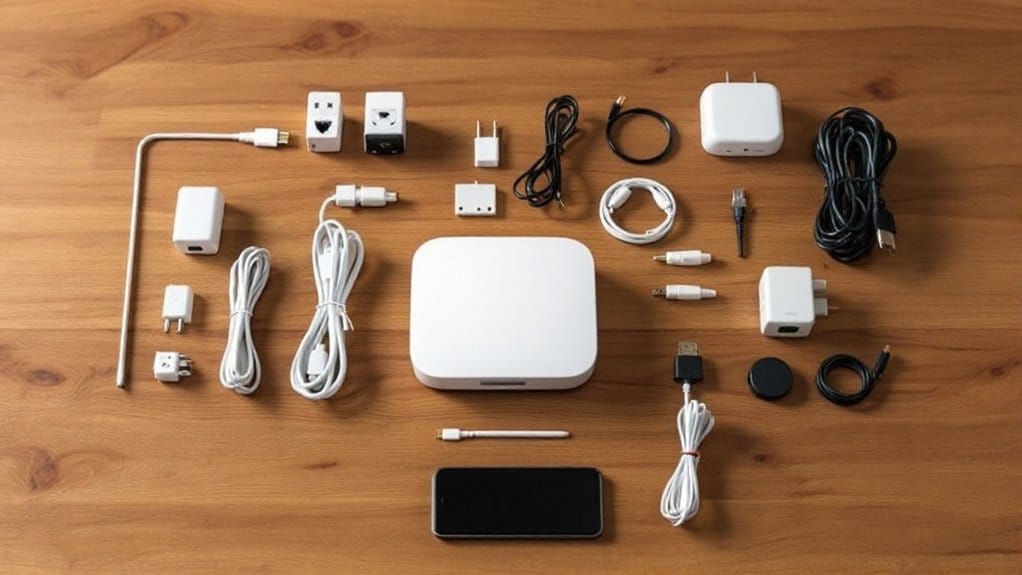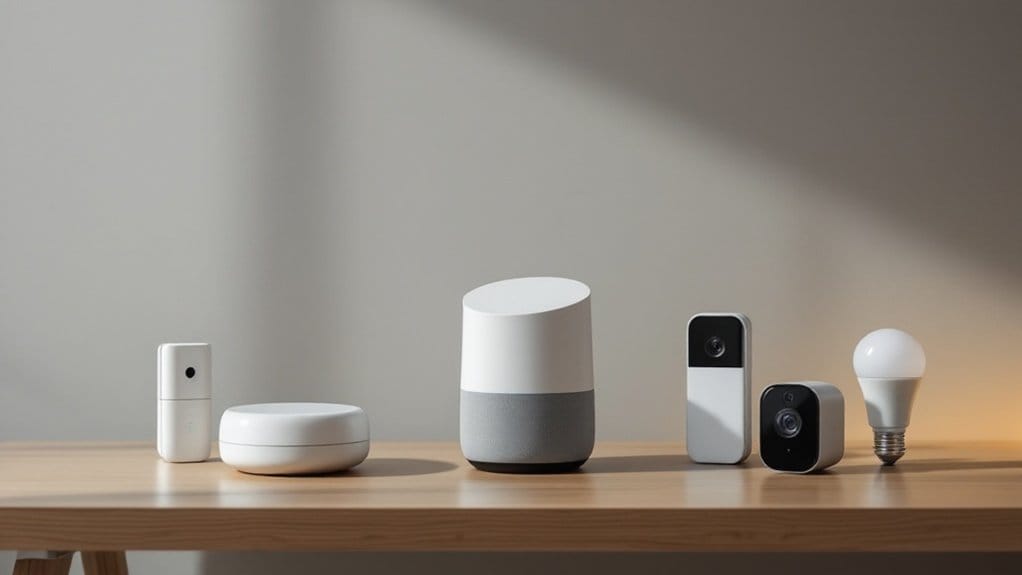You’ve witnessed smart home technology’s shift from glitchy devices to seamless setups that adapt to your life. As you ponder these changes, consider how early innovations paved the way for today’s smart, efficient homes—leading to exciting future possibilities.
Early Gadgets and Their Challenges
The early gadgets in smart home technology, like automated thermostats and remote-controlled lights, promised convenience but often fell short. You installed them hoping for effortless control, yet they glitched constantly, forcing you to reset systems manually.
Compatibility problems meant your devices wouldn’t communicate, turning simple tasks into frustrating battles. You’d spend evenings fiddling with unreliable connections, as these gadgets demanded technical expertise you didn’t have.
Power outages or software bugs left you in the dark, literally and figuratively, undermining the very convenience they advertised.
Despite their innovative appeal, early models were clunky and error-prone, making you question if the smart home dream was worth the hassle.
Over time, these challenges highlighted the need for better design, as you navigated a landscape of unmet expectations and frequent disappointments.
This era taught you that true smart living required more than just gadgets—it needed reliability and ease.
Pioneering Technologies in the 20th Century
In the 20th century, groundbreaking inventions like the X10 protocol and early automated systems began reshaping home automation.
You experienced this shift as X10 let you control lights and appliances through simple wired signals, turning your home into a responsive environment with just a switch or timer.
Imagine flicking a remote to dim your living room lights or scheduling your coffee maker—it’s what made daily life easier and more efficient.
These systems, though basic, demanded wiring that connected devices directly, fostering reliability over today’s seamless integrations.
You relied on them to automate routines, reducing energy waste and enhancing comfort without the complexity of modern apps.
This era’s innovations laid a foundation where you actively managed your space, proving that technology could simplify chores while sparking curiosity about what’s next.
The Era of Wireless Connectivity
Wireless connectivity transformed your home automation experience, ditching cumbersome wires for seamless, remote-controlled devices.
Wireless connectivity revolutionizes home automation, swapping tangled wires for effortless, remote-controlled devices.
You now control your lights, thermostats, and security systems effortlessly through apps on your smartphone.
Bluetooth and Wi-Fi protocols enable quick setup, letting you add devices anywhere in your home without drilling holes or managing cables.
This shift boosts reliability; devices communicate reliably over networks, reducing failures from physical connections.
You’re free to expand your setup—add smart plugs or sensors that integrate via wireless hubs, enhancing convenience and energy efficiency.
Gone are the days of tangled messes; instead, you enjoy a flexible, user-friendly environment that adapts to your lifestyle.
As wireless standards evolve, you’re empowered to create a truly modern, wire-free haven that prioritizes simplicity and accessibility.
Integration of Artificial Intelligence
Artificial intelligence builds on wireless setups by infusing your smart home with learning capabilities that adapt to your habits. It analyzes your daily routines, like when you wake up or return home, and automatically adjusts settings for maximum efficiency.
For instance, your thermostat learns to preheat the house just before you arrive, saving energy without any extra effort from you. AI-powered devices, such as smart speakers and security systems, predict your needs and respond proactively, making your space feel intuitive and responsive.
You’re no longer managing gadgets; they’re working for you, evolving over time to enhance comfort and convenience. This seamless integration reduces manual interventions, allowing you to enjoy a truly personalized environment that anticipates your lifestyle changes and optimizes performance accordingly.
Advances in User Interface Design
Advances in user interface design have transformed how you interact with smart home systems, making them more intuitive and accessible.
Now, you control devices effortlessly through voice commands, like telling your assistant to dim the lights or adjust the thermostat.
Touchscreen panels and mobile apps let you swipe and tap with precision, eliminating clunky remotes and complex menus.
Designers prioritize personalization, so you customize dashboards to fit your preferences, streamlining daily routines.
Gone are the days of frustrating setups; today’s interfaces use simple gestures and AI-driven suggestions to anticipate your needs.
This evolution enhances user engagement, as you navigate settings with ease, fostering a seamless experience that adapts to your lifestyle.
Ultimately, these innovations make smart homes feel like an extension of yourself, responsive and user-centric.
Energy-Efficient Smart Solutions
As smart homes grow more interconnected, energy-efficient solutions help you minimize consumption without sacrificing comfort.
Today, smart thermostats learn your habits and adjust temperatures automatically, slashing energy use during peak times.
You can control lighting systems via apps, dimming LEDs based on occupancy or natural light to conserve power effortlessly.
Energy-monitoring devices track appliance usage in real-time, alerting you to inefficiencies and suggesting optimizations.
For example, smart plugs schedule high-energy tasks for off-peak hours, reducing costs without disruption.
Integrating these with solar setups lets you store and utilize renewable energy effectively.
By adopting these innovations, you’re not only lowering bills but also fostering sustainability, making your daily life more efficient and eco-conscious.
Ultimately, these tools empower you to create a greener home seamlessly.
Security Features and Innovations
While energy-efficient systems make your home smarter, protecting it from threats becomes equally important. You now rely on cutting-edge security features that have transformed home defense.
Smart locks with biometric scanners let you grant access instantly, eliminating traditional keys’ vulnerabilities. AI-powered cameras detect motion and recognize faces, sending real-time alerts to your device for quick action. Integrated sensors monitor doors, windows, and even environmental hazards like smoke or floods, all from a unified app.
You control everything with voice commands, making responses faster and more intuitive. Encryption protocols secure your data against hackers, while automated updates keep systems robust. These innovations empower you to safeguard your space effectively, blending technology with peace of mind.
Emerging Trends and Future Prospects
What lies ahead for smart homes as technology races forward?
You’ll encounter AI-driven personalization that anticipates your needs, like adjusting lighting based on your mood or optimizing energy use for sustainability.
You’ll encounter AI-driven personalization that anticipates your needs, like mood-based lighting or sustainable energy optimization.
Emerging trends include edge computing for faster, local data processing, reducing reliance on cloud servers, and seamless 5G integration for real-time device communication.
You’ll also see expanded IoT ecosystems, where appliances interconnect with wearables to monitor health, alerting you to potential issues before they arise.
Voice assistants will evolve into intuitive home managers, handling everything from security to entertainment with natural language.
In the future, quantum computing promises ultra-fast analytics for predictive maintenance, while enhanced cybersecurity secures your data stays protected.
This shift will make your living space not just smart, but profoundly adaptive and efficient.
Conclusion
As you’ve witnessed, smart home technology has evolved from clunky, glitch-prone gadgets to seamless systems that use AI to learn your habits and automate routines. You’ve gained wireless ease, energy efficiency, and enhanced security, transforming your home into an adaptive haven. With emerging trends like 5G, you’ll shape even more personalized, interconnected spaces for a smarter future.









